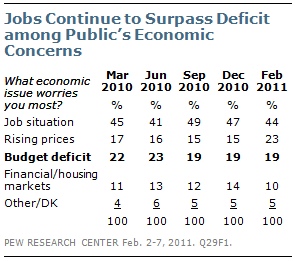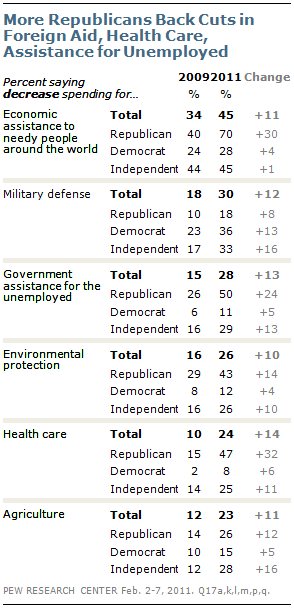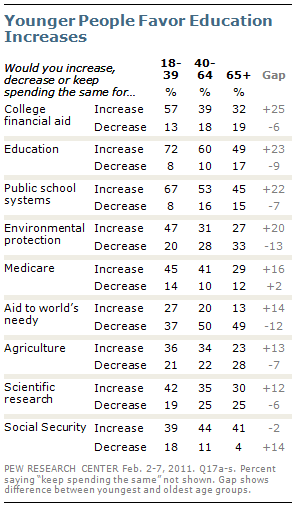Overall, the public is divided over whether it is more important for the federal government to reduce the  budget deficit or spend to help the economy recover. About half (49%) say that reducing the budget deficit should be the federal government’s higher priority, while nearly as many (46%) say the priority should be spending to help the economy recover. This is comparable to the balance of opinion nearly two years ago, when the public was asked to choose between reducing the budget deficit (46%) and spending more to help the economy recover (48%).
budget deficit or spend to help the economy recover. About half (49%) say that reducing the budget deficit should be the federal government’s higher priority, while nearly as many (46%) say the priority should be spending to help the economy recover. This is comparable to the balance of opinion nearly two years ago, when the public was asked to choose between reducing the budget deficit (46%) and spending more to help the economy recover (48%).
Over the past year, there has been no increase in the number of Americans who cite the budget deficit as the economic issue that worries them most. The job situation (44%) remains the top economic concern, followed by rising prices  (23%) which is up from 15% just two months ago. About one-in-five (19%) cite the deficit, which is largely unchanged since last March.
(23%) which is up from 15% just two months ago. About one-in-five (19%) cite the deficit, which is largely unchanged since last March.
While a large majority of Republicans (70%) prioritize deficit reduction over spending on economic recovery, they are divided over which economic issue worries them most. About as many Republicans cite the job situation (39%) as the budget deficit (36%).
By a slight margin (51% to 44%), independents place a higher priority on reducing the deficit over spending to help economic recovery. More than twice as many independents say the job situation (44%), rather than the budget deficit (19%), is their top economic concern.
Democrats, by contrast, place a higher priority on spending to boost the recovery (by 64% to 32%). Half of Democrats (50%) say the job situation is the economic issue that worries them most while just 8% cite the budget deficit.
More Still Favor Spending Increases than Spending Cuts
The public’s taste for cuts in federal government spending on specific programs remains limited. More want to see spending increased than decreased on 15 of 18 issues tested. The only area where a plurality favors decreased spending is on economic assistance to needy people around the world; even here, just under half (45%) support spending cuts, while 21% say spending should be increased and 29% want to keep spending the same. In two other areas – military defense and assistance for the unemployed – the numbers favoring cutbacks are roughly equal to the numbers favoring increases.
While there is modest support for spending cuts, substantial numbers are willing to see spending held steady. Pluralities say government spending on anti-terrorism defenses and unemployment assistance should be kept the same.
In this regard, majorities favor either cuts or spending freezes on 15 of the 18 issues tested. Education, public schools and veterans’ benefits are the only areas where half or more favor increased spending.
Growing Support for Less Spending
 Public attitudes about government spending have changed substantially over the past two years. For 12 of the 13 issues where 2009 trends are available, either support for increased spending has fallen or support for spending cuts has grown (or both).
Public attitudes about government spending have changed substantially over the past two years. For 12 of the 13 issues where 2009 trends are available, either support for increased spending has fallen or support for spending cuts has grown (or both).
Terrorism defenses is the only area where there has not been a statistically significant shift in a more austere direction over the past two years.
The largest shift in public spending preferences since 2009 is in the area of health care. The share of Americans who want the government to spend more on health care has fallen from 61% in 2009 – during the early stage of the debate over health care legislation – to 41% today. The proportion favoring decreased spending for health care has more than doubled since then, from 10% to 24%. Nearly half of Republicans (47%) want cuts in funding for health care, up from just 15% two years ago.
There also is growing support for less spending on aid to the unemployed and national defense. In both cases, as many now favor cutting spending as increasing spending. Two years ago, more supported increasing spending by wide margins.
Even on some popular budget items, such as Medicare and veterans’ benefits, there have been sharp declines in the percentages favoring more spending – 13 points for Medicare and 12 points for veterans’ benefits and services. On both issues, the balance of opinion is still toward expanded rather than decreased spending, but by a significantly narrower margin than in 2009.
At the other end of the spectrum, the public has in the past been less enthusiastic about spending on economic assistance to needy people around the world than on other priorities. Two years ago 34% said this should be cut back, and this has risen to 45% today.
Republicans tend to be more supportive of reducing spending across most issues, and their views have often shifted further  in the past two years, leading to even larger partisan differences in spending preferences. The share of Republicans who want to reduce spending on foreign aid spiked from an already high 40% in 2009 to 70% today, while Democratic and independent attitudes remained relatively steady.
in the past two years, leading to even larger partisan differences in spending preferences. The share of Republicans who want to reduce spending on foreign aid spiked from an already high 40% in 2009 to 70% today, while Democratic and independent attitudes remained relatively steady.
Fully half (50%) of Republicans today say spending on unemployment assistance should be decreased, roughly double the share who said this two years ago (26%). And Republican support for reductions in spending on health care and environmental protection has also risen substantially.
By contrast, Democrats and independents increasingly favor cutting the defense budget.
Currently, 36% of Democrats and 33% of independents would like to see defense spending reduced, up from 23% and 17%, respectively, in 2009. Just 18% of Republicans want to see defense spending reduced, up from 10% two years ago.
Wide Partisan Differences
Overall, Republicans are far more supportive of spending cuts across a wide range of issues, while Democrats tend to favor spending increases. On 16 of the 18 issues tested, more Democrats favor increasing spending than decreasing spending. By comparison, the Republican balance of opinion favors spending increases on six issues: education, public schools, veterans’ benefits, crime, terrorism and defense.
Meanwhile, more Republicans favor cuts than increases on four of the 18 items. There is no program for which significantly more Democrats support cuts rather than increases.
Overall, Democrats’ and Republicans’ spending preferences differ the most on aid to the unemployed and health care. In both areas, roughly half of Democrats want to see spending increased and roughly half of Republicans want to see it reduced.
There also are wide gaps over funding for foreign aid and environmental protection. By 70% to 7%, Republicans favor cutting, rather than increasing, aid for needy people around the world. Democrats are more evenly divided (32% increase, 28% decrease). Nearly half of Democrats (47%) support increasing spending for environmental protection while nearly as many Republicans (43%) want to decrease spending in this area.
Fully 77% of Democrats support increased spending on education, compared with 45% of Republicans. On the specific issue of financial aid for college students, 51% of Democrats favor providing more funding while just 9% would cut funding; as many Republicans would cut as increase spending on financial aid for college students (30% each).
On many of these issues, independent views fall roughly in between the Republican and Democratic positions. But on a few key items, independents’ spending preferences are far closer to those of Democrats than Republicans. Notably, independents support increased spending on college financial aid and on rebuilding highways, bridges and roads at nearly the same rate as Democrats. Conversely, 36% of Democrats and 33% of independents favor cuts in defense spending, compared with only 18% of Republicans.
Independents’ spending preferences are significantly closer to Republicans on only one issue: agriculture. While Democrats favor more rather than less agriculture spending by a 37% to 15% margin, both Republicans and independents are about as likely to favor cuts as increases (Republicans: 29% increase, 26% decrease, independents: 31% increase, 28% decrease).
Younger People Favor More Increases
Young people are more supportive than are older people of increased government spending on a number of  programs – particularly education. By 72% to 8%, more people younger than 40 want to see federal spending on education increased rather than decreased. Support for increased education spending falls to 60% among those ages 40 to 64 and 49% among those 65 and older. Seniors are twice as likely as those under 40 to say education spending should be cut.
programs – particularly education. By 72% to 8%, more people younger than 40 want to see federal spending on education increased rather than decreased. Support for increased education spending falls to 60% among those ages 40 to 64 and 49% among those 65 and older. Seniors are twice as likely as those under 40 to say education spending should be cut.
Similar age differences are evident on specific education programs – funding for public school systems and financial aid to college students.
There also is a wide age gap on spending for environmental protection. By 47% to 20%, people under age 40 want to see environmental spending grow rather than shrink. But just 27% of those 65 and older favor more spending on environmental protection while 33% support less spending.
The one issue younger people are more willing to cut is Social Security. Nearly one-in-five of those younger than 40 (18%) say Social Security spending should be cut, compared with 11% of those ages 40-64 and just 4% of those 65 and older. Even so, far more in every age group would rather see Social Security spending increased than decreased.


